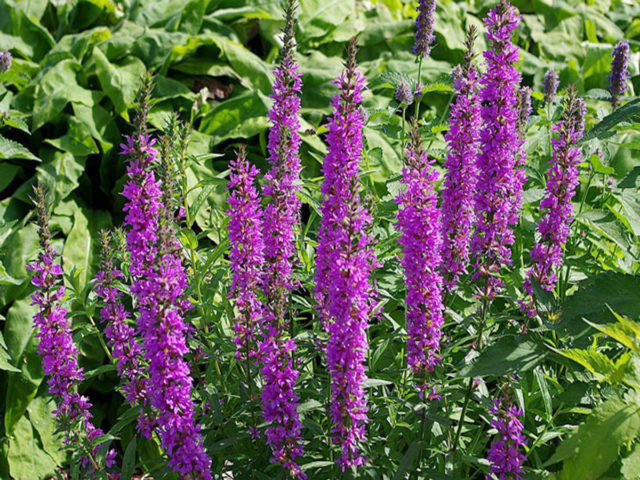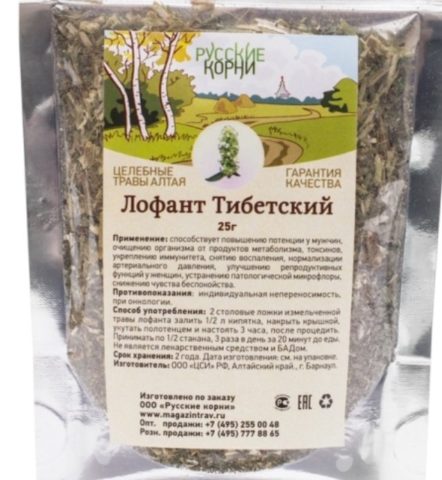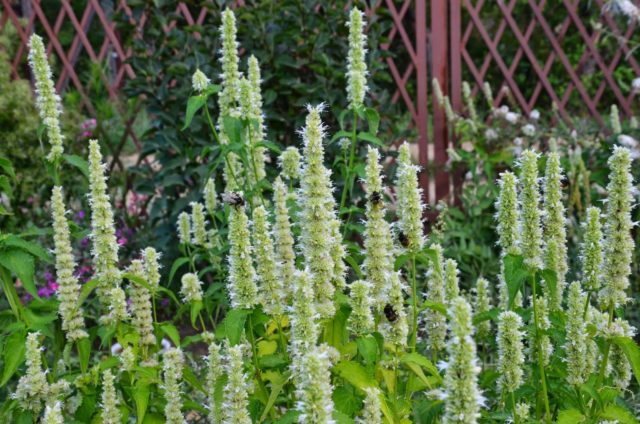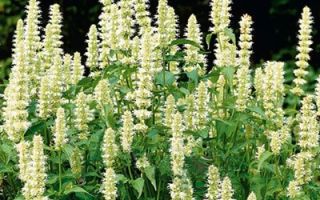Content
- 1 The chemical composition of the Tibetan lofant
- 2 Differences between aniseed and Tibetan lofant
- 3 The benefits of the Tibetan lofant
- 4 The harm of the Tibetan lofant
- 5 Contraindications to Tibetan lofant
- 6 Rules for the use of Tibetan lofant
- 7 The use of Tibetan lofant in traditional medicine
- 8 Conclusion
- 9 Reviews of the Tibetan lofant
Tibetan lofant (lat.Agastache foeniculum) is a well-known medicinal plant, which is often called Korean mint. This herb is a natural immunostimulant, and in its qualities is in many ways similar to ginseng, but it acts more sparingly and longer. With regular use, the body's defenses increase. But before using it, it is recommended to study in more detail the beneficial properties and contraindications of the Tibetan lofant, so as not to unwittingly harm health.

The chemical composition of the Tibetan lofant
For medicinal purposes, the ground part of the plant is used, since it is here that all the useful components for human health are concentrated.
The chemical composition of the Tibetan lofant includes:
- alkaloids;
- kaempferol and glycosides;
- flavonoids;
- rutin;
- quercetin;
- astragalin;
- tannins;
- organic acids;
- terpenes;
- tannin;
- ethers;
- routine.
Despite such a variety of components, this plant is not used in traditional medicine. The reason is insufficiently studied properties of culture. The latest research in this area was carried out in 1992, and they are taken as a basis.
Differences between aniseed and Tibetan lofant
Lofant in botanical reference books is called a multi-grate. This plant includes 11 different species, each with its own characteristics. But only one type of plant has unique medicinal properties - the Tibetan lofant. It is similar in appearance to aniseed. But the latter is used more in cooking. It does not differ in unique healing properties.
The color of flowers in anise lofant (lat.Agastache foeniculum) can be purple or pinkish-blue, and in Tibetan - white, lilac, blue. The height of the plant in the first species reaches 45-150 cm, and in the second - 40-100 cm. But based on these differences, it is quite difficult to determine exactly where which plant is.
It is also necessary to take into account the country of origin, as well as the characteristic aroma of the herb. Anise lofant grows in North America, and Tibetan - in Asia. The aroma of the first is intense like that of anise, which served as the name of the species. The second has a less pronounced smell.
But people who are far from botany from the first time will hardly be able to determine the species. Therefore, in order to obtain high-quality medicinal raw materials, it is necessary to purchase the seeds of the Tibetan lofant and grow it on your site.

The benefits of the Tibetan lofant
The plant has a whole range of useful properties, which is widely popular in folk medicine.
Funds based on it have the following qualities:
- cleanse the body of toxins;
- normalize metabolic processes;
- accelerate recovery after an illness;
- relieve nervous tension;
- have a bactericidal, anti-inflammatory effect;
- help reduce bad cholesterol;
- normalize blood pressure;
- cleanse the skin.
Folk remedies based on Tibetan lofant are appreciated for their mild effect on the body. At the same time, a prolonged healing effect is observed. This means that healing occurs gradually after a while, and at the same time it is felt even after the end of the course of therapy.
The medicinal properties of Tibetan lofant are effective for:
- inflammation of the urinary system;
- diseases of the digestive system, liver;
- dermatitis of allergic or fungal origin;
- muscle, headache;
- hypertension;
- angina pectoris;
- bronchitis;
- cough;
- pneumonia;
- gastritis;
- peptic ulcer;
- vegetative dystonia;
- atherosclerosis;
- insomnia;
- infertility.
This plant is widely used in cosmetology. Regular use of products based on Tibetan lofant helps to strengthen hair follicles, get rid of dandruff, and also activates hair growth.
The harm of the Tibetan lofant
Subject to all the rules of admission during treatment with a Tibetan lofant, it cannot harm health. Deterioration of well-being occurs only when the dosage is significantly exceeded, as well as as a result of individual intolerance.
In this case, the following signs may appear:
- nausea;
- dizziness;
- skin rashes;
- vomiting;
- headache.
If the symptoms are caused by ignoring the daily norm, it is recommended to take a break in treatment for 5-7 days so that the body has time to cleanse itself of the accumulated active substances. After that, you can resume treatment, but adjusting the dose.
Contraindications to Tibetan lofant
No significant contraindications have been identified for this plant. But in some cases, the medicinal properties of the plant can be harmful to health.
It is not recommended to use it when:
- pregnancy;
- lactation;
- individual intolerance;
- thrombophlebitis;
- oncological diseases;
- hypotension.
There is no need to experiment with health in the presence of serious chronic pathologies and after undergoing surgery, since in this case the Tibetan lofant can worsen the situation.
Rules for the use of Tibetan lofant
It is necessary to start taking folk remedies based on this medicinal plant with a small dosage. And then gradually increase it.
It is necessary to prepare all the products without adding alcohol in small quantities, since they can be stored for no more than three days in the refrigerator.
When taken orally, a healing agent should be drunk for a week, and then take a break for three days. If necessary, the course of therapy can be repeated, but not earlier than three months later.

The use of Tibetan lofant in traditional medicine
The plant has found wide application in folk medicine. It is not difficult to prepare healing remedies based on it at home. But at the same time, all indicated dosages should be observed so as not to harm health.
Effective folk remedies:
- Infusion... For the preparation of a medicinal drink 2 tbsp. l. Pour 500 ml of boiling water over the dried flowers of the plant. Soak for 1 hour, and then clean from impurities. Reception is carried out three times a day, drinking 100 ml. This recipe for Tibetan lofanta infusion helps against pressure, diseases of the digestive system, urinary system, and also helps to strengthen the immune system.
- Broth. For cooking, you need to pour 50 g of the collection with 500 ml of hot water and boil for 10-15 minutes. over low heat. After the drink has cooled, it must be cleaned. Reception is carried out three times a day, 100 ml before meals. This decoction is recommended for asthma, bronchitis, sore throat, tuberculosis, as well as colds and to strengthen the immune system.
- Tincture... The recipe requires 200 g of inflorescences, leaves and shoots to pour 500 ml of vodka. Pour the mixture into a dark glass container and close the lid tightly. Insist for 30 days, occasionally shaking the bottle. After the waiting period, the agent is recommended to be taken orally in the morning, at lunchtime and in the evening according to the scheme 10:20:10 drops, respectively. Before drinking the product, dilute it with 100 ml of water. The benefits of Tibetan lofant tincture have been proven for heart disease, atherosclerosis and for strengthening the immune system.
- Tea... For cooking, you need 1 tbsp. l. Tibetan lofant flowers steam 400 ml of boiling water. Insist for half an hour, drink a warm drink three times a day, 100-200 ml, regardless of food intake. Honey can be used to improve the taste. Tea based on Tibetan lofant is recommended for prostatitis, cystitis, and it also promotes recovery from an illness and helps to increase the level of hemoglobin.
- Gel... This product requires only fresh leaves of the plant - 100 g. They need to be finely chopped until smooth and mixed with 30 g of riciniol, which can be purchased at the pharmacy. Pour 50 ml of unrefined olive oil into the resulting mass, mix everything thoroughly and use for treatment. This gel is effective for eczema, furuncles, fungal dermatitis. It should be applied in an even layer on the affected areas every 3 hours until complete recovery.

Conclusion
Knowing the useful properties and contraindications of Tibetan lofant, we can say with confidence that this plant is unique. And when used correctly, it can help address certain health problems. A clear advantage of the Tibetan lofant is that the likelihood of side effects when using it is minimal. And few medicinal herbs are distinguished by this quality.

